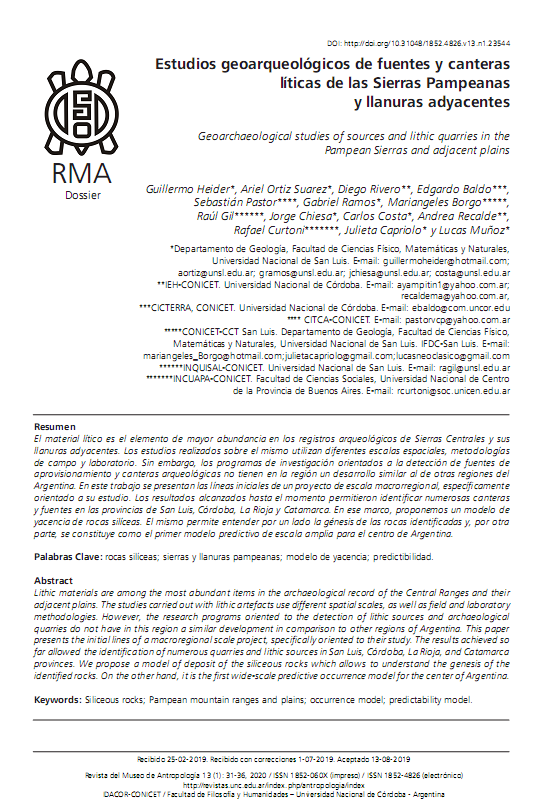Geoarchaeological studies of sources and lithic quarries in the Pampean Sierras and adjacent plains
DOI:
https://doi.org/10.31048/1852.4826.v13.n1.23544Keywords:
Siliceous rocks, Pampean mountain ranges and plains, occurrence model, predictability modelAbstract
Lithic materials are among the most abundant items in the archaeological record of the Central Ranges and their adjacent plains. The studies carried out with lithic artefacts use different spatial scales, as well as field and laboratory methodologies. However, the research programs oriented to the detection of lithic sources and archaeological quarries do not have in this region a similar development in comparison to other regions of Argentina. This paper presents the initial lines of a macroregional scale project, specifically oriented to their study. The results achieved so far allowed the identification of numerous quarries and lithic sources in San Luis, Córdoba, La Rioja, and Catamarca provinces. We propose a model of deposit of the siliceous rocks which allows to understand the genesis of the identified rocks. On the other hand, it is the first wide-scale predictive occurrence model for the center of Argentina.
Downloads
References
Aschero, C. (1975-1983). Ensayo para una clasificación morfológica de artefactos líticos. Informe a CONICET. Ms.
Aschero, C. y Hocsman S. (2004). Revisando cuestiones tipológicas en torno a la clasificación de artefactos bifaciales. Temas de Arqueología. Análisis Lítico: 7-25.
Basaez, A. y Chiesa, J. (2014). Análisis de facies de la Formación Paso de las Carretas (Neógeno, San Luis). Actas del XIX Congreso Geológico Argentino T1: 7. Córdoba, Argentina.
Borgo, M., Heider, G., Ramos G. y Curtoni R. (2017). Primeros avances en el área de canteras La Falla (San Luis). Congreso Argentino de Estudios Líticos en Arqueología: 32-34. Córdoba.
Caminos, R. (1979). Sierras Pampeanas Noroccidentales. Salta, Tucumán, Catamarca, La Rioja y San Juan. 2 Simposio Geología Regional Argentina (1) 225–291. Córdoba.
Cattaneo, R., Sario, G., Caminoa, J., Collo, G., Rubio, M., Germanier, A., Faudone, S., Izeta, A. y Salvatore, M. (2018). Caracterización química de fuentes de abastecimiento e instrumental arqueológico de cuarzo de la provincia de Córdoba (Argentina). pp 50. VII Jornadas Arqueológicas de Cuyo, Malargüe.
Dahlquist, J., Rapela, C., Baldo, E. (2005). Petrogenesis of cordierite-bearing S-type granitoides in Sierra de Chepes, Famatinian orogen, Argentina. Journal of South American Earth Sciences, 20: 231–251
Ebert, J. (1992), Distributional Archaeology. University of New Mexico Press, New Mexico.
Ezpeleta, M., Dávila, F. y Astini, R. (2006). Estratigrafía y paleoambientes de la Formación Los Llanos (La Rioja): una secuencia condensada Miocena en el antepaís fragmentado andino central. Revista de la Asociación Geológica Argentina 61 (2): 171-186.
González, A. (1952). Antiguo horizonte precerámico en las Sierras Centrales, Argentina. Runa V: 110-133.
González Bonorino, F. (1950). Algunos problemas geológicos de Sierras Pampeanas. Revista de la Asociación Geológica Argentina 5 (3): 81-110
Heider, G y Demichelis A. (2015). Loma de Los Pedernales, a local raw material source in the North of Pampa Seca, Argentina. Quaternary International 375: 3-12.
Heider G., Rivero, D. y Baldo, E. (2015). Rocas de uso arqueológico en Sierras Centrales. Fuentes de recursos líticos identificadas y potenciales en las provincias de Córdoba y San Luis, Argentina. Revista de Antropología del Museo de Entre Ríos 1 (2): 55-72.
Heider G., Ortiz Suarez, A., Gil, R., Perino, E., Chiesa, J., Basaez, A., Bazán C., y Díaz I. (2017). Chert´s source in Las Travesías from the center of Argentina. A case study in the arid zone. 11th International Symposium on knappable material, “From toolstone to stone tools”.156-157. Buenos Aires y Necochea, Argentina.
Irigoyen, M. (1981). Geología y recursos naturales de San Luis. VIII Congreso Geológico Argentino. Buenos Aires.
Iriondo, M. (1990). A Late Holocene dry period in the Argentine Plains. Quaternary of South America and Antarctic Peninsula 7: 197-218.
Llambías, E, Caminos, R., Cingolani, C., Prozzi C., Ortíz Suarez, Saavedra A. y Toselli, J. (1991). Las granodioritas sincinemáticas de la Sierra de San Luis. 6° Congreso Geológico Chileno: 187-191.
Limarino, O., Poma, S. y Miró, R. (1999). Hoja Geológica Chamical 3166 – I. Provincias de La Rioja, San Luis y San Juan. Programa Nacional de Cartas Geológicas 1:250.000. SEGEMAR.
Nami, H. (1992). El subsistema tecnológico de la confección de instrumentos líticos y la explotación de los recursos del ambiente: una nueva vía de aproximación. Shincal 2: 33-53.
Politis, G. y Barros P. (2003-2004). La región Pampeana como unidad espacial de análisis en la arqueología contemporánea. Folia Histórica del Nordeste 16: 51-73.
Sario, G. (2013). Sources of lithic material procurement in Estancia La Suiza archeological locality (San Luis, Argentina). Journal of Archaeological and Anthropological Sciences 5(3): 245-254.
Sario, G, Pautassi E. y Salvatore M. (2017). Canteras-taller El Ranchito (Dpto. Ischilín, Córdoba). Una primera aproximación en la caracterización de fuentes y al análisis de los conjuntos líticos. Revista del Museo de Antropología, Suplemento especial 1: 59-64
Sayago, J. (1979). Geomorfología del Valle de San Alberto. Provincia de Córdoba. 7º Congreso Geológico Argentino 2: 89–107.
Waters, R. (1992). Principles of Geoarchaeology. The University of Arizona Press, Tucson.

Downloads
Published
Issue
Section
License
Those authors who have publications with this Journalaccept the following terms:
a. Authors will retain their copyrights and guarantee the journal the right of first publication of their work, which will be simultaneously subject to the Creative Commons Attribution License (Licencia de reconocimiento de Creative Commons) that allows third parties to share the work as long as its author and his first publication in this journal.
b. Authors may adopt other non-exclusive licensing agreements for the distribution of the version of the published work (eg, deposit it in an institutional electronic file or publish it in a monographic volume) provided that the initial publication in this journal is indicated.
c. Authors are allowed and recommended to disseminate their work on the Internet (eg in institutional telematic archives or on their website) before and during the submission process, which can lead to interesting exchanges and increase citations of the published work. (See The Effect of Open Access - El efecto del acceso abierto)











